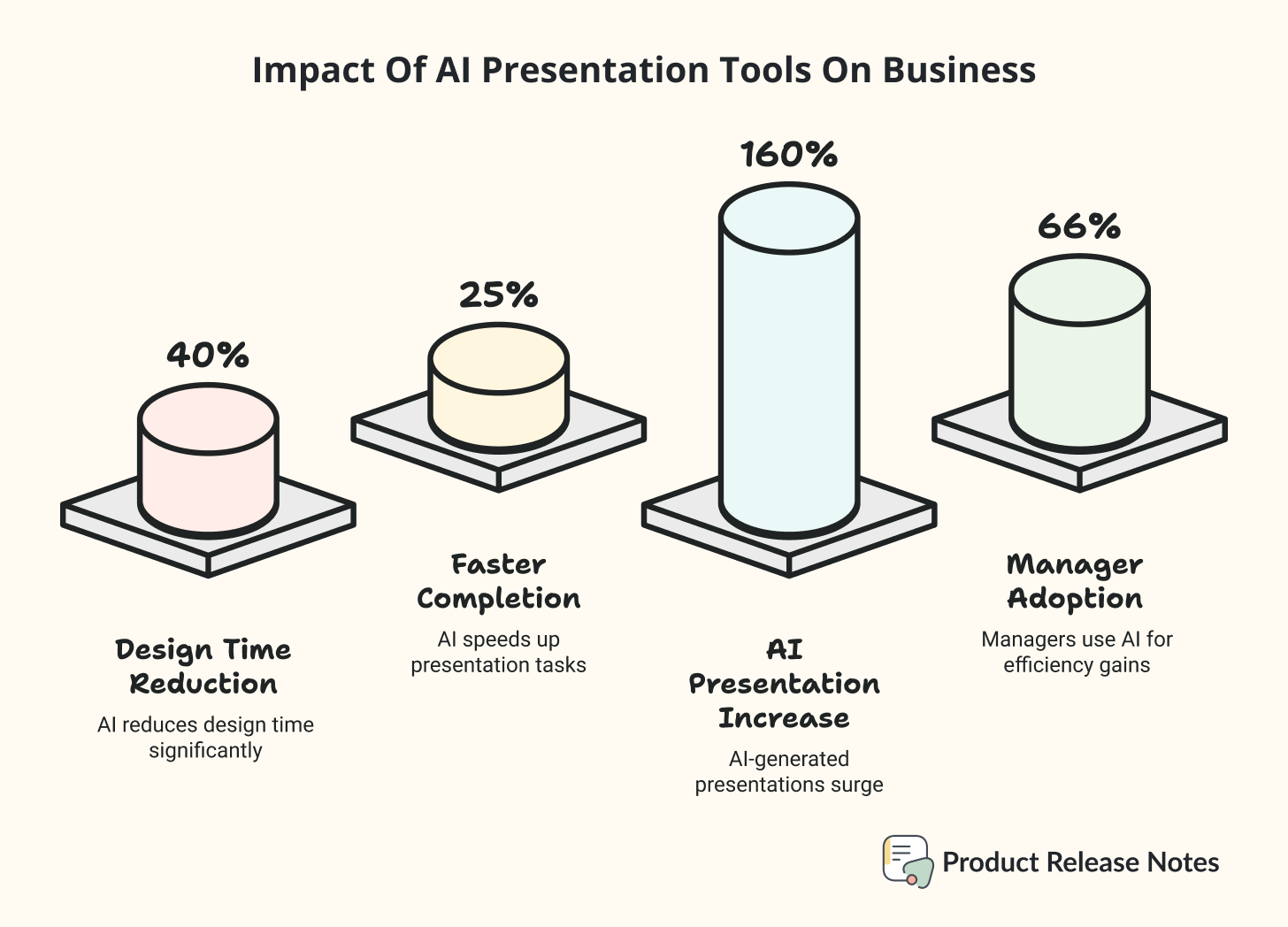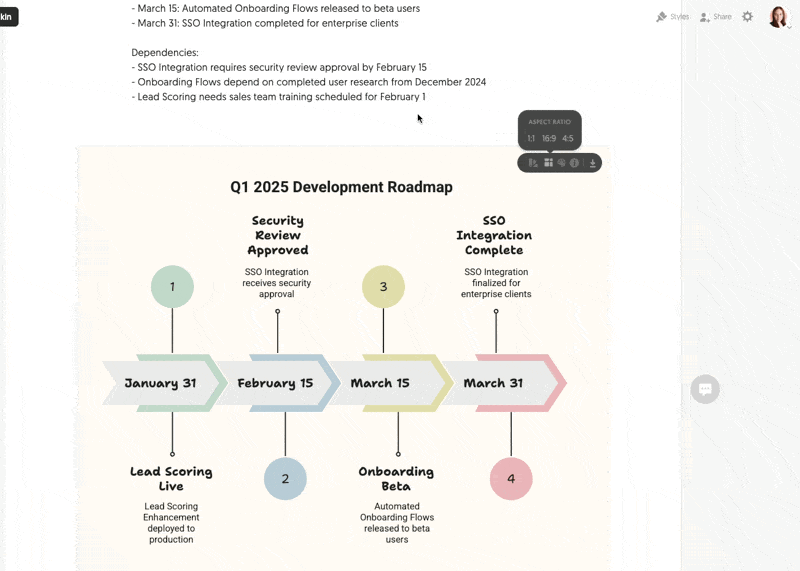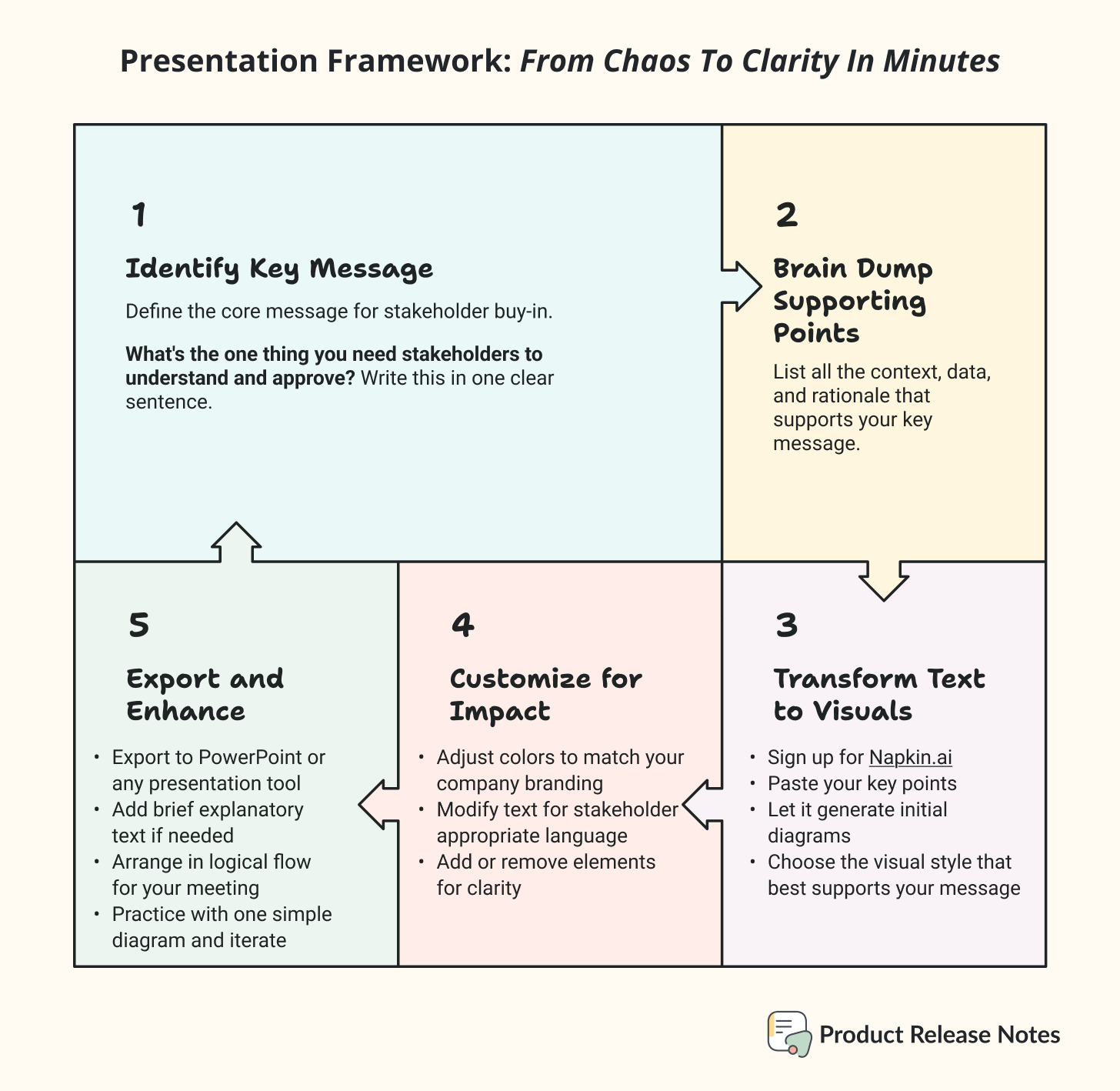How I Won Over Stakeholders With AI Presentations In Minutes, Not Hours
The era of spending entire weekends building presentations is over. Here’s how smart product managers are using AI to create visually stunning, stakeholder-ready decks that actually get results.
This post is sponsored by Napkin.ai, Napkin turns your text into visuals so sharing your ideas is quick and effective.
Picture this: It’s 4 PM on a Friday, and your CEO just called an “urgent” Monday morning meeting with the board. They want a comprehensive presentation on your product strategy, complete with visual roadmaps, competitive analysis, and financial projections.
The old you would panic. The new you just opens your laptop and gets to work.
Thanks to AI tools like Napkin.ai, what used to be a weekend-crushing marathon of slide building can now be done in under an hour. But this isn’t just about speed. It’s about creating presentations that actually persuade stakeholders to say “yes” to your ideas.
After watching countless product managers struggle with stakeholder buy-in, I’ve discovered something fascinating: the difference between approval and rejection often comes down to how well you communicate your ideas, not just how good they are.
Let’s dive into how AI is transforming the way we communicate with stakeholders and why visual storytelling has become the ultimate competitive advantage for product managers. 👇
The Presentation Problem That’s Killing Product Managers Time
Something that is truth, but also brutal, about stakeholder presentations: 47% of presenters spend over 8 hours designing a single deck. For product managers, this number is often much higher because we’re dealing with complex technical concepts, market data, and strategic roadmaps that require careful visualization.
But time isn’t the only problem. Research shows that presentations with visuals are 43% more persuasive than those without. Yet most product managers still default to text-heavy slides that lose stakeholder attention within minutes.
The math is simple but devastating:
Creating effective visuals: 6-8 hours per presentation
Stakeholder attention span for text-heavy content: Less than 5 minutes
Information retention from visual presentations: 65% vs. 10% for text-only
When you combine low visual impact with massive time investment, you get a recipe for frustrated stakeholders and burned-out product managers.
And I’ve been there. Spending entire days building presentations, only to watch stakeholders scroll through their phones while I explain complex product architecture through bullet points. 🥲 Something had to change!
Why Visual Communication Is Your Secret Weapon
The science behind visual communication is, actually, very interesting. Our brains process visual information 60,000 times faster than text. When you show a stakeholder a well-designed diagram instead of explaining it verbally, you’re literally working with their brain’s natural processing speed.
But here’s what you may be missing: 77% of business leaders say visual communication increased their business performance. This isn’t just about making prettier slides. Really, visual communication directly impacts business outcomes! 💥
The Visual Advantage for Product Managers
As product leaders, we’re already creating visual content every day:
Product roadmaps that communicate priorities and timelines
User flow diagrams that illustrate customer journeys
Data visualizations that tell stories at a glance
Wireframes and mockups that bring ideas to life
The problem isn’t that we don’t understand the importance of visuals. The problem is that creating professional-quality visuals traditionally required design skills most of us don’t have.
That’s where AI changes everything. 🤖
How AI Presentation Tools Are Changing The Game
The AI presentation tools market has exploded from $1.2 billion in 2024 to an estimated $1.48 billion in 2025. The compound annual growth rate of 23.3% tells us something important: businesses are desperately seeking solutions to the presentation problem.
But the real breakthrough isn’t in the market size. It’s in the results.
Companies using AI presentation tools report:
40% reduction in design time
25% faster completion of presentation tasks
160% increase in AI-generated presentations from 2023 to 2024
What’s driving this adoption? 66% of managers are using AI tools to boost efficiency, and presentations are often the first place they see immediate results.
Napkin.ai: My Game-Changer for Stakeholder Presentations
After testing many AI presentation tools, Napkin.ai stands out for one crucial reason: it transforms text into professional diagrams without requiring any prompting or design skills. What I love about this is you don’t even have to chat like ChatGPT and wait for a random image over and over again! Let’s see why:
Instant Visual Transformation
Paste your product requirements document → Get a visual process flow
Describe your go-to-market strategy → Receive a professional timeline diagram
Explain your technical architecture → See it rendered as a clear system diagram
Professional Quality, Zero Design Skills
Customizable colors, fonts, and layouts
Multiple export formats (PNG, PDF, SVG, PowerPoint)
Real-time collaboration for team input
Stakeholder-Ready Output
Branded visuals that match your company style
Clean, professional diagrams that stakeholders actually understand
Formats that integrate seamlessly into existing presentation workflows
Here is the access to the Napkin I used for all these examples. Play with it, customize it, destroy it if you want. Have some fun! 😉
The Napkin.ai Unfair Advantage
Let me walk you through how I used Napkin.ai to solve a real stakeholder challenge couple of months ago.
The Situation: Our engineering team was pushing back on a product roadmap timeline, while the sales team was pressuring for faster feature delivery. I needed to present a revised timeline that showed the trade-offs visually.
The Old Approach: Would have required hours in PowerPoint, manually creating Gantt charts, dependency diagrams, and resource allocation visuals. Probably would have taken my entire weekend.
The Napkin.ai Approach:
Wrote out the roadmap constraints in plain English (10 minutes)
Generated high-level visual timeline showing some dependencies (2 minutes)
Created resource allocation diagram highlighting bottlenecks (3 minutes)
Customized colors to match company branding (3 minutes)
Exported to PowerPoint for final presentation (1 minute)
Total time: 19 minutes.
Let’s be fair and add another 15 minutes for customization, because I need to use my company’s PowerPoint template and double-check for errors, plus another 4 minutes of me staring at the screen. 38 min It’s still a insignificant amount of time to get full stakeholder buy-in. 🤯
The visual impact was immediate. Instead of explaining complex interdependencies, stakeholders could see them. The engineering concerns became obvious, and the sales team understood the constraints. We reached an agreement in a single meeting, instead of the usual three follow-up meetings.
Why Napkin Over Others?
I know you might be thinking, “Elena, there are already AI tools that create complete presentations from a single prompt.” I know! But let me explain why I recommend it:
Those tools may be great for startups, but I work at a large company and need to follow the PowerPoint format. I can get rid of that. That’s why I choose Napkin over other presentation tools, because I can easily export to PowerPoint, PNG, or SVG.
For example, in my newsletter, I use Figma to include my logo and other details, so it’s very convenient that Napkin allows exporting in SVG. I can even edit the icons if necessary!
The first 50 Product Release Notes friends get a 20% discount on their first time purchase. Just use the coupon code PRNOTES during checkout.
More Than Speed, It’s About Engagement
The time savings are obvious, but the real benefit is increased stakeholder engagement and better decision-making.
Just as I take care with the graphics in my articles to capture the audience’s attention, the same applies to presentations.
Research shows that effective stakeholder engagement leads to 78% project success rates, compared to only 40% with less engaged stakeholders. Visual presentations are one of the most reliable ways to increase engagement because they:
1️⃣ Reduce Cognitive Load
Complex product information becomes digestible when visualized properly. 65% of people are visual learners, so you’re working with their natural preferences.
2️⃣ Create Shared Understanding
Visual diagrams eliminate ambiguity. When everyone can see the same process flow or timeline, miscommunications drop dramatically.
3️⃣ Enable Faster Decision-Making
Stakeholders can process visual information and identify potential issues or opportunities much faster than with text-based presentations.
4️⃣ Build Credibility
Professional visuals signal that you’ve invested time and thought into your proposal. Well-crafted data visualizations show stakeholders that you’ve organized and presented your data professionally.
The Competitive Advantage You Have Now
While your peers are still spending days building presentations, you can be iterating on strategy, talking to customers, or actually solving product problems.
But the real advantage isn’t personal productivity. It’s stakeholder influence.
When you can rapidly create professional visuals that clearly communicate complex ideas, you become the product manager who “gets things done.” Stakeholders start coming to you for clarity on complex topics because they know you’ll present information in ways they can actually understand and act on.
I don’t know if this “visual/presentation credibility” is a real term, but what I know is that the reputation for being someone whose presentations are worth attending because they’re clear, actionable, and visually engaging it’s really something.
Steal My Framework 👉 From Chaos to Clarity in Minutes
Based on months of experimentation, here’s my proven framework for creating stakeholder-winning presentations with AI:
Step 1: Identify Your Key Message (3 minutes)
Choose one upcoming stakeholder presentation where you need buy-in on a complex topic. What’s the one thing you need stakeholders to understand and approve? Write this in one clear sentence.
Step 2: Brain Dump Your Supporting Points (5 minutes)
List all the context, data, and rationale that supports your key message. Don’t worry about organization yet. Maybe use ChatGPT or your custom agent, I rely on Perplexity for this because it knows very well my work now.
Step 3: Transform Text to Visuals (10 minutes)
Sign up for Napkin.ai (they offer a free tier for testing) - Go here
Paste your key points into Napkin.ai
Let it generate initial diagrams
Choose the visual style that best supports your message
Step 4: Customize for Impact (10 minutes)
Adjust colors to match your company branding
Modify text for stakeholder-appropriate language
Add or remove elements for clarity
Step 5: Export and Enhance (3 minutes)
Export to PowerPoint or your presentation tool of choice
Add brief explanatory text if needed
Arrange in logical flow for your meeting
Practice with one simple diagram – maybe a user flow or process you explain regularly so you can do an initial test.
⬇️⬇️⬇️
How to take action now?
📅 In a month:
Apply the presentation framework to at least three stakeholder presentations.
Track stakeholder engagement for example: note questions, feedback, and decision speed.
Refine your approach based on what works best for your stakeholder groups.
🗓️ Or within this quarter:
Build a library of visual templates for common presentation scenarios.
Share your approach with other product managers (building internal credibility).
Measure impact like faster approvals, clearer feedback, better stakeholder relationships.
Final Thoughts
AI as Your Presentation Multiplier
I won’t still your relationship with your stakeholders, don’t panic! But many product managers are regaining valuable time to do things that they enjoy:
If you enjoy meeting people, you can focus more on the conversation now
If you enjoy data analysis, you can spend more time there
If you really enjoy customizing graphics but don’t have time to create them or how, well you can do that too.
The ability to rapidly create professional, persuasive visual presentations is becoming a core competency. In a world where stakeholder attention is increasingly scarce, being able to communicate complex ideas clearly and visually isn’t just nice to have, it’s a MUST.
The question isn’t whether you should incorporate AI presentation tools into your process, but rather whether you can afford to continue sacrificing your time adjusting PowerPoint presentations.
What are your thoughts on AI-powered presentations? Have you experimented with visual storytelling tools for stakeholder communication? Drop your experiences in the comments! 👇
Want to try Napkin.ai for yourself? They’re offering 20% off your first time purchase, for the first 50 friends of Product Release Notes to get this great deal! Just use the coupon code PRNOTES during checkout.
Use my experience as a starting point, but remember, the real magic happens when you combine AI efficiency with your unique product insights. Until next issue!







Oh napkin looks great! I’ll have to try it out. My current go to when I have a sudden presentation is to take my laptop to the pub. It’s surprising how much more focussed I am there with a beer to help tame the overthinking. Your version sounds much more responsible 😁
Napkin was a game changer for me too.
So simple and efficient to create visuals. And they keep adding new templates that make more and more relevant over time.
A new recent addition for presentations I found is nano banana for infographics/cheatsheets.
And I can include visuals made with napkin into it.